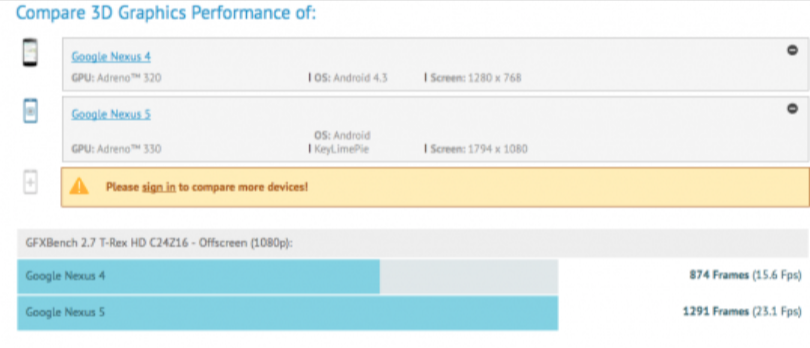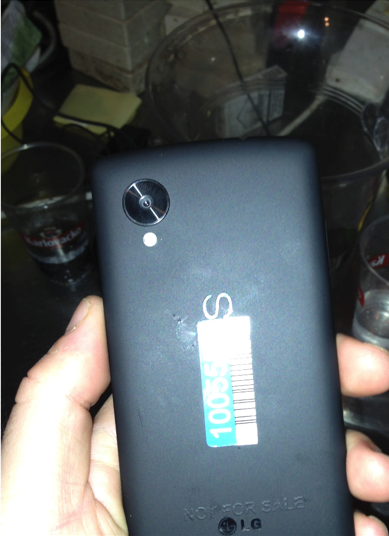As if we aren’t excited enough about the Nexus 5 bar visit from photos earlier this week, we’re now hearing that the Nexus 5 is making its way into benchmark testing. This is important because benchmark tests usually show the performance of a device prior to its release onto the market. While benchmarks cannot tell consumers everything about the device (nor its performance in real time), apps such as Geekbench 3 are trying to change this mindset that has become a mantra on the typical consumer tongue.
Benchmark scores aren’t everything, but, in this case, they provide more information about the Nexus 5 than we knew before. The devil is in the details.
GFX Benchmark Test: What Else Can It Tell Us About the LG Nexus 5?
The GFX benchmark test performed between the Nexus 5 and the 2012 Nexus 4 shows that the Nexus 5 outperforms the Nexus 4. First off, the benchmark results tell us that the Nexus 5 will use an Adreno 330 graphics processor while the Nexus 4 (running Android 4.3 Jelly Bean, the latest Android OS upgrade) sports an Adreno 320 graphics processor unit. What’s the big deal about graphics processors, you ask? The graphics will be better with the higher graphics processor in the Nexus 5.
In the same way that newer processor chips increase the speed of your device for video watching, movie watching, game playing, and so on, graphics processors provide more detailed graphics on-screen as newer processors come along. In this case, 3D graphics will be more beautiful than ever before. Like the 2013 Nexus 7’s screen resolution, you won’t be able to return to the Nexus 4 screen resolution once you feast your eyes on the Nexus 5 display.
Next, we see that the new Google phone will be called the Nexus 5. Some had said prior to the recent leaks that Google may decide to call it a “second-gen. Nexus 4,” but we see the name clearly in the GFX benchmark.
Last but not least, we see that the Nexus 5 graphics will be affected to enhance the on-screen user experience. While recent rumors said that the Nexus 5 will have a screen resolution of 1920 x 1080p, the GFX benchmark places the Nexus 5 screen resolution at around “1794 x 1080.” The reason for this is likely the fact that there will be on-screen buttons to take away from the on-screen graphics. The display will still be beautiful nonetheless. The Nexus 4’s on-screen buttons (three of them) are at the bottom of the screen, and it seems that Google would like to maintain this tradition with the new Nexus 5.
Android 5.0 Key Lime Pie on the Nexus 5?
One of the more interesting things to notice about the Nexus 5 GFX benchmark is the idea that the new Nexus 5 is running “Key Lime Pie” for its current OS. This could be an error because Google just announced Android 4.4 KitKat earlier this month, but it could also be a reminder of Google’s first choice of OS nomenclature before settling on KitKat as the new name for Android 4.4.
Keep in mind that, according to yesterday’s bar photos, the Nexus 5 bears the date of August 20th – leading us to believe that the Nexus 5 was being worked on for some time before its release.
Could Android 5.0 Key Lime Pie still have a release for the end of the year? It seems unlikely at this point, since Android 4.4 KitKat has been named as the new OS upgrade. It seems unlikely that Google would announce Android 4.4 KitKat, then turn around and surprise us all with Android 5.0 Key Lime Pie by December.
If the above GFX benchmark is showing Key Lime Pie, what could be the reason? If you ask me, I think the KLP designation dates the benchmark to some time before Google’s announcement, which means that the Nexus 5 benchmark we’re seeing in the photo was conducted some weeks ago.
If you notice, the Nexus 4 is running Android 4.3, which wasn’t announced until July 24th for the Nexus 4, 7, and 10. This means that the decision to change the new OS nomenclature could not have come until after the Android 4.3 release, possibly last month.
The Nexus 5, as shown in the bar from yesterday, shows a Jelly Bean lock screen on the new device. Since Google likely changed its mind about the new OS in December, it’s likely that the Jelly Bean lock screen was left on the device to not give away the new OS.
At the same time, however, it seems likely that Google tested the device out last month with KLP so as to not give away the change of the OS from Key Lime Pie to KitKat before the Android 4.4 KitKat announcement earlier this month. Google employees were told to continue to use the KLP designation, even when the new KitKat name had been designated.
From what we know, the new Nexus 5 will sport Android 4.4 KitKat alongside of a 2.26Ghz, quad-core Qualcomm Snapdragon 800 processor, 1080p full HD display, 2GB of random access memory (RAM), and the 1920 x 1080p screen resolution (some reduction here due to the on-screen buttons). It has been said that Android 4.4 KitKat will be released on October 14th, the same day that the new Nexus 5 will be announced. As for when the Nexus 5 will be released, the end of October is likely.




